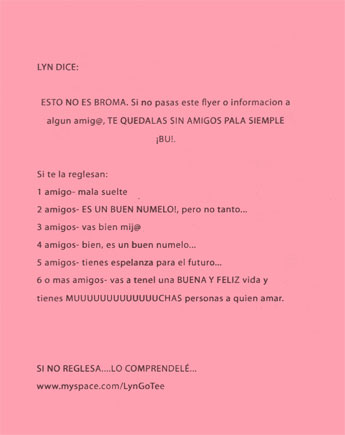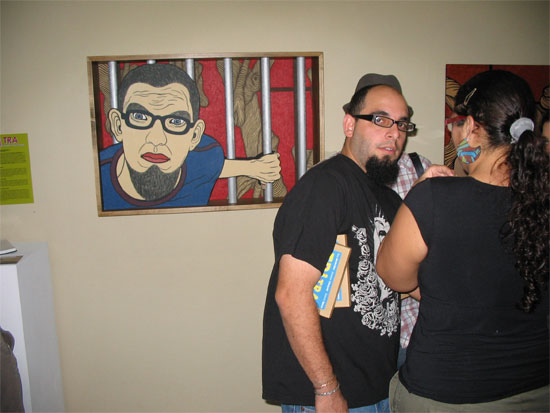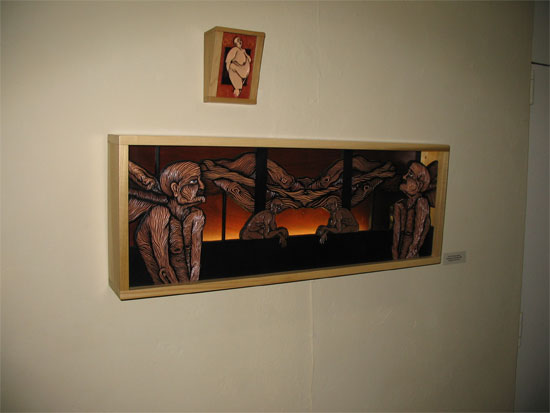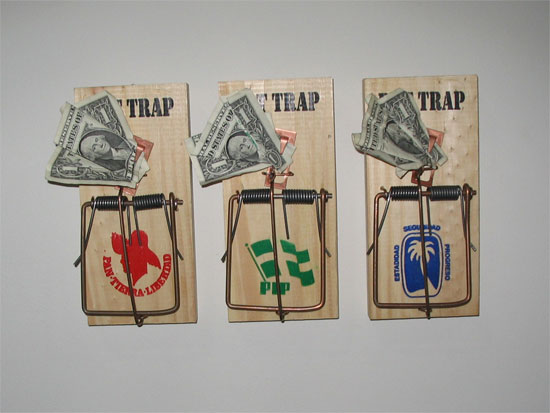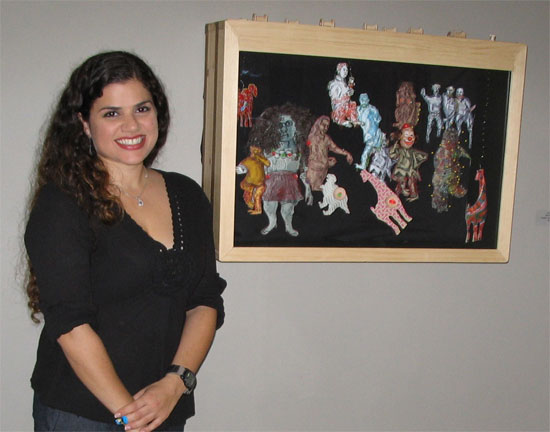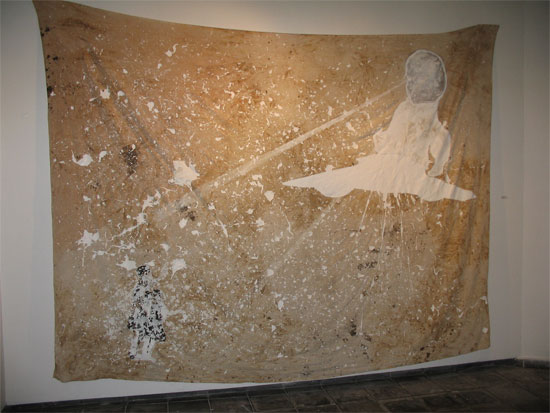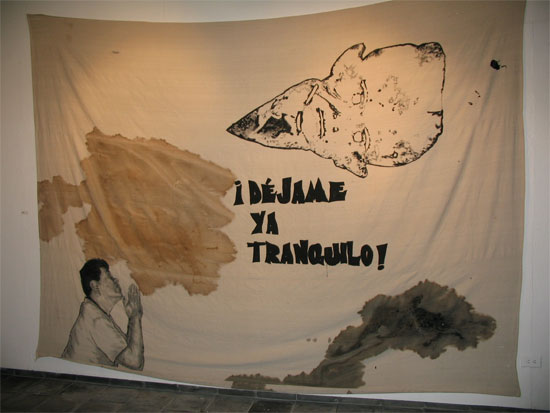|

Fee, Fi, and Fo¡Puerto Rico! You just have to love it. Well, you don’t have to. In fact, there’s plenty to make you red in the face. The political system is absolutely nasty, driven by naked greed and a braying, bullying arrogance, and worm-eaten with corruption. The infrastructure is crumbling before our eyes: uncontrollable traffic heaving itself over cratered byways at terrifying speeds, mega-developments chomping up the tasty bits of what little native culture and unspoiled landscape remain for the blithe pleasure of a few obscenely wealthy beachhogs and golfing would-be princelings. Prices are skyrocketing with the abandon of a small-town Fourth of July—no coincidence—and the art world muddles about within its own bubble of self-regard, mutual jealousies, and what-the-fuck, blissfully ignorant of the world currents that are dragging a once-meaningful calling into a miasma of commercialism and utter pointlessness. Not that we mind. In fact, compared to sectarian blood lust, outright starvation, and mass hypnotism by zealous, money-grubbing bigots, life in Puerto Rico suits us fine. The youths come out at night with their crude fliers brimming with cheeky felicity. “A marathon of figure drawing,” one declares as if it was nothing, and another, a very pink handbill with big hair and high cheekbones, says, “Proyecto Nómada,” promising a night of “Fotografía Hurtado,” which may or may not translate as “stolen photography.” We trust there’s no jail time involved. 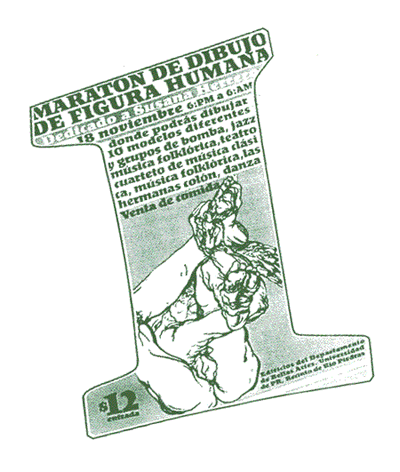
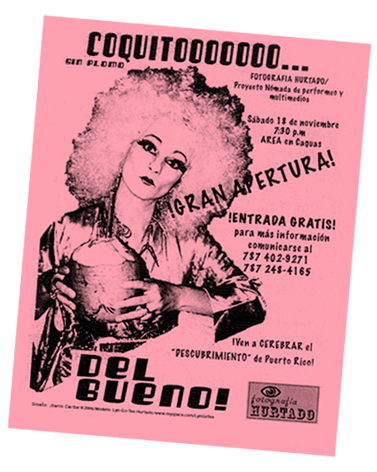
Both of these events occur during a very, very busy weekend, on Saturday, November 18. The “Marathon of Figure Drawing” will take its exhuasting course from 6 p.m. until 6 the next morning at Edificios del Departamento de Bellas Artes, Universidad de Puerto Rico, Recinto de Rio Piedras. Twelve smackers at the door. The “Proyecto Nómada de performeo y multimedios” (that’s exactly what the flyer says, folks) is happening at ÁREA in Caguas beginning at 7:30 p.m. and it’s free. There are numbers you can call for informeo: 787-402-9271 and 787-248-4165. We can’t vouch for Proyecto Nómada, but as per the backside of its flyer—shown below—we expect a wacky good time.
Back in our usual groove, there was a spate openings last week, including the much-trumpeted Tri Tra—Grabado Experimental at the now reliably cool =Desto. Curator Raquel Quijano invited Elsa Meléndez, Garvin Sierra, and Myriam Vázquez—artists who, to some degree and at least some of the time, are printmakers— and asked them to apply traditional printmaking techniques to three-dimensional projects. Now, this might sound entirely counter-intuitive unless you’ve seen Quijano’s own work. She has been known to create architecturally complex little boxes which she calls “prints,” so it’s no surprise that the concept for her show is likewise off the wall. The opening was jammed not only with the customary exuberant crowd but with a rather more steely-eyed element which we’re in the habit of calling the usual suspects. This always gets a laugh from the upstarts since we’re so usually suspicious ouselves.
We know it’s a small art world, filled with goateed young men, but don’t be fooled by passing resemblances as we were. Look at the art work below—by Myriam Vázquez—and tell us that the fierce mien of the portrait is not the same fierce mien looking askance at the camera. Omar Obdulio Peña Forty, left, meet Garvin Sierra, right. How do you do?
Above is another of Vázquez’s works, “Deschados in Venustidad,” mixed media, 13.75" x 37", 2006. Each of her pieces appears to be a plate for a woodcut print, usually painted as if a canvas, some involving interior lighting. Garvin Sierra, on the other hand, applies iconic imagery to a broad range of everyday household objects, such as rat traps and toilet paper. Like a lot of artists of a critical-conceptual bent, he favors currency as a medium. His work often has a political cast—an over-simplified way to describe it might be “anti-capitalist”— and so it tends to suffer a degree of obviousness. But his blatant choices, offered up with diligent workmanship and a wry off-handedness, can also be affecting and funny. “Trampa para ratas,” below (rubber stamp, wood, metal, dollar bills, dimensions variable, 2006), represents both the short and the long of Sierra’s work; the long being its place in an exhibition weighted more on the side of psychology than social criticism.
Sierra’s unvarnished presentation of the iconography of the island’s political parties gives his critique added bite, but more importantly as far as the exhibition is concerned, it also ties the work solidly to the Puerto Rican printmaking tradition, where national symbology has always been stage front. Elsa Meléndez’s hands-on fairy tales are stagy in a very different way, and to an altogether different effect, although her archetypes—clowns, fuzzy animals, the artist herself—also dwell in the collective consciousness; in the dank psychological crannies, perhaps, rather than the insistent rational mind. Meléndez makes a quixotic game out of our desire to manage the unmanageable and in this way her project is the most conceptually ambitious of the show, and the most liberal interpretation of the notion of printmaking.
Meléndez, above, stands beside her work, “Circo social II.” The characters can be moved, in a limited way, by means of the thread spools visible at the top of the box, so that anyone can share in the illusion of stage-managing primordial memories. Watch Goldilocks chase the three bears through the woods! (The box’s innards are made of itaglio print on paper filled with cotton and sewn and embroidered with thread. In addition, there are magnets, synthetic hair, wire, and the head of a plastic clown. Watch out, clown haters. The wooden box measures 21.5" high by 28" wide x 7.5" deep.) “The road goes on forever, and the party never ends,” as a wise pop singer once muttered. There are plenty of openings yet to cover, but frankly we’re wearing down. Aren’t you? We’ll move briskly through a couple of the other shows of note, in the faint hope that we can give them adequate coverage in the future. Presently, we also wish to correct a misimpression regarding one of our favorite shows in recent memory, José Luis Vargas’s Museo de historia sobrenatural at La Liga de Arte, which is set to close already. Fie on shows that only last a few weeks!
We had characterized Vargas’s paintings as “fine,” meaning “okay”—the presumption of some people—and more specifically said, “Vargas makes good use of the grunginess of the giant canvases, especially when miscellaneous stains present themselves as malign spirit-forms or, in the case of an expiring Toni B, the phemonemon of a dying man pissing upwards . . . ” To our immense chagrin, a return to La Liga de Arte revealed that the canvases had no stains that the artist did not put there; that they were in no way “grungy” or in any state other than pristine before Vargas himself sullied them by spritzing gobs of paint—as in the eerie, baby-headed “Pelo de Angel,” top—or by applying mock splotches, as in the disturbing “Plegaria,” below. Our apologies to the artist, as if he cares. On to the next thing, here. |


